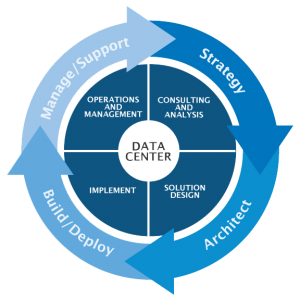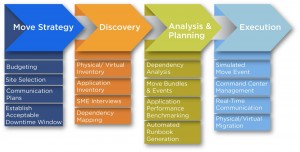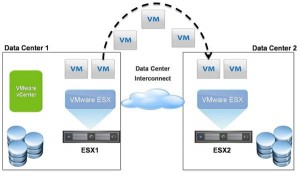Migration Strategy
Develop, utilize, and manage a repeatable, scalable, and defined process to move existing applications to the new data center.Use an inventory  template for data gathering and application bundling. The inventory correlates each piece of hardware, operating software, application, and client. There needs to be a clear understanding of how the applications being migrated interact with other systems and applications, and the interdependencies should be included in the inventory.Leverage the latest reference guides, application migration checklists, and roadmap planning collateral. Adopt a quarterly planning cycle: two quarters ahead of go live, roadmap four to six quarters visibility.Align integrated road map bundle (logical grouping of applications) with ERMO quarterly and non-quarterly releases.Engage with application migration project managers and capacity management representatives to determine the number of applications that can move based on resource and funding allocations.Integrate planning with the resiliency and DeVirt teams. [/av_textblock] [/av_one_half] [av_one_half min_height=” vertical_alignment=” space=” custom_margin=” margin=’0px’ padding=’0px’ border=” border_color=” radius=’0px’ background_color=” src=” background_position=’top left’ background_repeat=’no-repeat’] [av_tab_container position=’top_tab’ boxed=’border_tabs’ initial=’1′] [av_tab title=’Data Center Relocation’ icon_select=’no’ icon=’ue800′ font=’entypo-fontello’] Traditionally, a data center “Relocation” primarily involved physically moving racks of equipment from one location to another. Over the last several years, however, the IT computing landscape has changed, and today’s “virtual” data centers typically include a broad range of physically hosted, virtualized, SaaS and cloud-deployed applications. Many IT professionals refer to the relocation of applications from physical servers to virtual instances (either internally managed with technology like VMware, or deployed into the cloud), or from one virtual/cloud location to another, as a “Migration.”
template for data gathering and application bundling. The inventory correlates each piece of hardware, operating software, application, and client. There needs to be a clear understanding of how the applications being migrated interact with other systems and applications, and the interdependencies should be included in the inventory.Leverage the latest reference guides, application migration checklists, and roadmap planning collateral. Adopt a quarterly planning cycle: two quarters ahead of go live, roadmap four to six quarters visibility.Align integrated road map bundle (logical grouping of applications) with ERMO quarterly and non-quarterly releases.Engage with application migration project managers and capacity management representatives to determine the number of applications that can move based on resource and funding allocations.Integrate planning with the resiliency and DeVirt teams. [/av_textblock] [/av_one_half] [av_one_half min_height=” vertical_alignment=” space=” custom_margin=” margin=’0px’ padding=’0px’ border=” border_color=” radius=’0px’ background_color=” src=” background_position=’top left’ background_repeat=’no-repeat’] [av_tab_container position=’top_tab’ boxed=’border_tabs’ initial=’1′] [av_tab title=’Data Center Relocation’ icon_select=’no’ icon=’ue800′ font=’entypo-fontello’] Traditionally, a data center “Relocation” primarily involved physically moving racks of equipment from one location to another. Over the last several years, however, the IT computing landscape has changed, and today’s “virtual” data centers typically include a broad range of physically hosted, virtualized, SaaS and cloud-deployed applications. Many IT professionals refer to the relocation of applications from physical servers to virtual instances (either internally managed with technology like VMware, or deployed into the cloud), or from one virtual/cloud location to another, as a “Migration.”  A smooth, trouble free, transformation of any or all of these environments is best archived through rigorous planning and disciplined relocation project management. ARPCO has extensive experience in all of these environments, across hundreds of move events. Our proven methodology removes risks and brings order and simplicity to your data center relocation project. We offer full-scope, turn-key migration services with PMP and ITIL based project management, certified technology professionals, and a wealth of experience moving physical assets and virtual/cloud-based data and hosts. [/av_tab] [av_tab title=’Application Transformation’ icon_select=’no’ icon=’ue800′ font=’entypo-fontello’] Re-architect applications, as needed, to operate optimally within the new data center environment. To contribute to overall system resiliency, applications are re-architected with failure and automated graceful recovery in mind. Retire sunset applications and platforms. Consolidate similar applications (e.g., reduce number of versions, instances, products, packages and functionalities, etc.)
A smooth, trouble free, transformation of any or all of these environments is best archived through rigorous planning and disciplined relocation project management. ARPCO has extensive experience in all of these environments, across hundreds of move events. Our proven methodology removes risks and brings order and simplicity to your data center relocation project. We offer full-scope, turn-key migration services with PMP and ITIL based project management, certified technology professionals, and a wealth of experience moving physical assets and virtual/cloud-based data and hosts. [/av_tab] [av_tab title=’Application Transformation’ icon_select=’no’ icon=’ue800′ font=’entypo-fontello’] Re-architect applications, as needed, to operate optimally within the new data center environment. To contribute to overall system resiliency, applications are re-architected with failure and automated graceful recovery in mind. Retire sunset applications and platforms. Consolidate similar applications (e.g., reduce number of versions, instances, products, packages and functionalities, etc.) Hot swing applicable applications. Involves setting up compatible hardware in the new data center and quickly switching over the applications that require minimal downtime (e.g., duration typically minutes to two hours). Cold migration of applicable applications. Involves setting up replacement hardware in the new data center for applications that can be offline for a longer duration; migration can be up to one day. Lift and shift applicable applications. Involves physical move of existing hardware and applications to the new location. It allows for multi-day downtime and is typically used for all non-business critical applications. [/av_tab] [/av_tab_container] [/av_one_half][av_one_full first min_height=” vertical_alignment=” space=” custom_margin=” margin=’0px’ padding=’0px’ border=” border_color=” radius=’0px’ background_color=” src=” background_position=’top left’ background_repeat=’no-repeat’][/av_one_full]
Hot swing applicable applications. Involves setting up compatible hardware in the new data center and quickly switching over the applications that require minimal downtime (e.g., duration typically minutes to two hours). Cold migration of applicable applications. Involves setting up replacement hardware in the new data center for applications that can be offline for a longer duration; migration can be up to one day. Lift and shift applicable applications. Involves physical move of existing hardware and applications to the new location. It allows for multi-day downtime and is typically used for all non-business critical applications. [/av_tab] [/av_tab_container] [/av_one_half][av_one_full first min_height=” vertical_alignment=” space=” custom_margin=” margin=’0px’ padding=’0px’ border=” border_color=” radius=’0px’ background_color=” src=” background_position=’top left’ background_repeat=’no-repeat’][/av_one_full]


